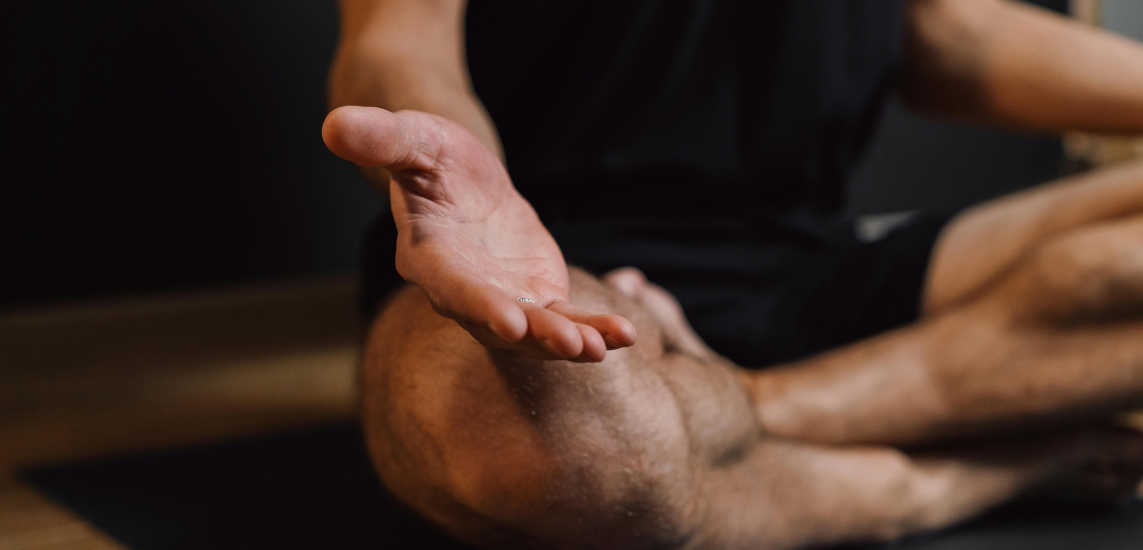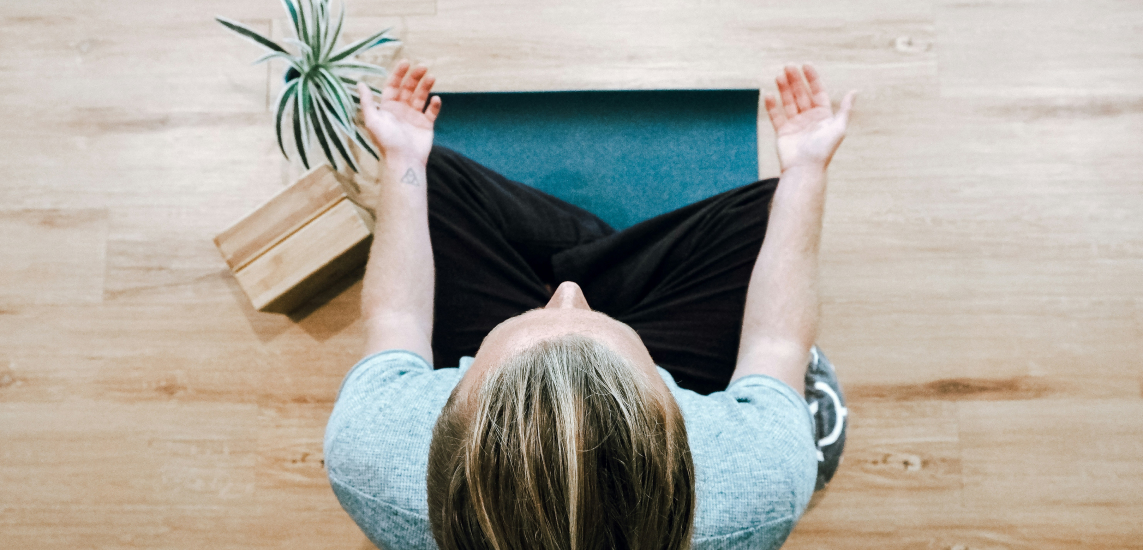Are you unsure how to turn the volume down on daily stress and anxiety? Psychologist and mindfulness teacher Elisha Goldstein shares seven daily habits to keep you grounded and focused, especially in turbulent times.
This text is a transcription of Elisha Goldstein’s talk on Insight Timer. Listen below:
- 7 Daily Habits To Ease An Anxious Mind And Be Happier Elisha Goldstein 19:44
- Sky of Awareness Elisha Goldstein 15:30
7 Daily Habits To Ease Stress And Anxiety
1. Recognize To Unwind
We’ll start very simple. The purpose of stress is to start ramping up our nervous system so we can either fight, flee, run away or freeze if things seem hopeless. Our nervous system is starting to amp up which tells our mind that there’s something impending or dangerous about to happen.
The first thing we want to do is move through our body and recognize it in this nervous system reaction. Just that first recognition brings more blood flow to the prefrontal region, which is involved with emotion, regulation and impulse control.
Once we recognize that and notice where we’re actually bracing in our body, we want to do the opposite. We want to begin to notice where the bracing is in our body and then unwind that.
Sometimes we can do that with our own mind, like softening muscles, taking a deep breath and just releasing and softening.
Other times, our muscles are really wound up because the anxiety response is really there. Anxiety is also a mixture of fear and uncertainty. The brain doesn’t really know what’s around the corner, so it brings up anxiety. And that could be imagined. That could be your brain just catastrophizing something that’s not actually happening.
Fear and uncertainty match up to create anxiety which, in turn, creates this nervous system reaction.
The bundle that’s happening within us wants to take a deep breath and just soften our bodies, or we can recognize where the tension or holding is in our body and begin to open it up a little bit.
In other words, we’re working through our bodies here, noticing where the tension is. I know for me, sometimes it’s in my chest. For other people, it’s in their stomach. For others it’s in their shoulders or in their face. We can begin to just open that part of our body up. And quite literally, we can just gently stretch or take our breath and expand it into that area of the body. Releasing by breathing out.
That’s the foundation The first step is to recognize where we’re bracing, begin to unwind and release it. You can literally shake it out if you want to or dance and move it that way. Whatever you want to do, you want to start loosen things up and soften it that way. We’re working through our body to shift our nervous system, which tells our brain that things are okay.
2. Recognize again
The stress response is ramping us up, getting us going fast. When we go fast, our brain also goes really fast. So we want to slow down a bit.
Again, we work through our body. We start doing slow physical movements. Quite literally. If you’re walking down the road, try walking slightly slower. If you’re moving in your house and doing dishes, try doing them just slightly slower. We don’t have to go slow motion. But moving slightly slower tells the brain that it doesn’t need to ramp up so much. Take it as the mantra of the day “Slightly slower”. If you’re showering, try not to shower so quickly, try doing it slightly slower.
By using our body to engage our body in this way, we’re sending the brain the opposite signal: “I don’t need to be so anxious. Maybe there’s not so much to worry about in this moment. Maybe I can just take back control of my mind and body.
That’s mindfulness, by the way. We’re using awareness, that space between stimulus and response, where choice, possibility and growth lie to realize perspective and more choice points. In this space, we’re saying “Okay, I’m choosing to go slightly slower and see what I notice.”
3. Build more certainty into your day
Remember, anxiety is fear and uncertainty. There’s nothing wrong with fear, it is a natural human emotion. It’s when fear gets mixed with uncertainty that creates this anxious feeling. That’s delivered to us all the time, through the news, through political figures and various other people. They find a variety of ways to create more uncertainty, which then creates anxiety.
It’s not a mystery why in 2020 we’ve moved from one in 12 people in the United States showing symptoms of anxiety disorder to one in three. What we want to do is say “What’s the opposite action of that? Let me see if I can build more certainty into my day.”
One of the ways of doing that is by creating routine. Whenever there’s instability, we want to help create certainty and stability. Think about your sleep, think about your exercise. Think about if you have a contemplate practice like a meditation. Think about the way you engage with the people who you live with. In what way can you start to create routine in your life? Maybe even put it in your schedule – “At this time, I do this.”
One of the issues with anxiety is that we activate the part of our brain that’s involved with self-referencing, so it’s always about ‘me’. What does it have to do with me? How is this going to impact me in the future? What does this have to do with me in the past? So much so that we get kind of sick of ourselves.So we want to build more certainty into our day to turn the volume down. A routine that’s about me getting outside of myself might be making sure that every day I contact someone that I care about and tell them what I really appreciate about them.
4. Come to your senses throughout the day
There’s an inverse relationship between the part of our brain that’s worrying, ruminating and self-referencing me, and the part of us that’s actually really present to our senses. If you’re eating a really great meal and you’re really into it, you’re really tasting that meal. Odds are you’re really not worrying that much in that moment. If you’re eating a really great meal, but you’re worrying a lot in that moment, you’re not really tasting that meal. If we practice coming to our senses – with our sense of smell, of hearing, of taste, of sight, a feeling or even sensing internally into our body, which is called interception – we we can turn the volume down on our world without even really trying.
Try this as an experiment. This is something I call three-by-three practice. It’s really simple:
Come to think about three things that you’re seeing right now. Then ask yourself what are three things I’m hearing right now? Then listen and see if you can identify three things that you’re hearing. Then, what are three things that you’re feeling right now and you can literally take your hands and actually feel these things.
You can make this a five-by-five practice or a three-by-three practice. But it’s something to just begin to experiment with. Next time you’re on a walk, go ahead and do this three-by-three practice and see how it allows you to really of ground a little bit more into your body and feel a little bit more connected to everything that’s around you. Anxiety and stress is an experience of disconnection. It’s our brain starting to self-reference ourselves, so we’re disconnecting from the world around us. With this practice, we’re shifting our focus because where our focus goes, we tend to invite an energy to flow. We’re focusing outside of ourselves and, therefore, we tend to take the energy away from the part of our brain that is igniting the worries, the stress and the catastrophizing.
Read more: A similar practice is the 54321 grounding technique. Learn more how this practice eases anxiety.
5. Release the critic
We’re so hard on ourselves a lot of the time. Every time we make a mistake, get in an anxious state, fall short from an expectation that we had or have a difficult interaction with somebody else, we get so hard on ourselves, telling ourselves that we’re not good enough or we’re deficient or defective in some way. That sham ignites the same centers of our brain as stress does by being self-critical. We actually pour stress on top of the stress and anxiety that’s already there and we exacerbate it.
One way of releasing it I mentioned in the first step, by recognizing it. Where do you brace here? We recognize that we’re being hard on ourselves in that moment. After that, we can begin to release it. We can recognize it. “Tis is a difficult moment right now. I’m being so hard on myself. That’s part of life. I’m not alone in this.” There’s millions and millions of people around the world that are so self-critical and hard on themselves. It’s almost like a habit. A really unhealthy mental habit. It’s good to look at ourselves and be curious and say “How can I improve?”
But typically that’s not the way it goes. We’re just pouring stress on top of the stress and anxiety that’s already there. So we say that this is a tough moment in life. There’s tough moments. Rather thwacking myself with a stick I am going turn towards myself and ask myself “What is it that I’m needing right now?” The essential question around self compassion. What am I needing right now? What I’m really needing right now is more acceptance. What I’m really needing right now is to release this self-critical voice and instead just go outside and take a walk. To hash this out with a friend or talk to a trusted source of some kind to communicate and figure out what went wrong or what I could do better next time.
What do I really need is the question. What. Because what you want to do is shift from kind of stabbing yourself in some way to being more supportive.
6. Do a reality check
One of my favorite ways to do a reality check is by going through Byron Katie‘s book for questions. These four questions are very simple, and this is my adaptation of them. You ask yourself –
That thought, that I’m going to lose my job for example, is that true? Yeah, it feels like it’s true.
Then ask, is it absolutely true? Am I certain that it’s true, one hundred percent? Well, I can’t say that it’s 100 percent true.
Here’s where the mindfulness piece comes in. We’re trying to objectify this thought, to do a reality check. I call this the truth teller machine. I ask “How does it make me feel?” It makes me feel scared inside when I think about it. “What does it make me want to do?” Not do that thing. This is where fear is controlling us. It makes me not want to do that thing. And guess what? What we resist persists. We’re realizing that this thought – that’s not even absolutely true – is really controlling us, making us feel really scared and also making us take an action (or no action) that, as a consequence, is going to increase and sustain anxiety and fear.
So then asked yourself “What would be different if this thought wasn’t here?” I’d probably have more energy to do that thing, to take that risk, to be more vulnerable. Maybe I would I’d feel more calm and feel more at ease. Another way of asking this “Who would I be without this thought?”
This is more of a reality check around what our emotional center of our brain is telling us and how it is filtering our perception.
7. Look up and listen
I want you to go somewhere, lie down on a patch of grass or even within your house. It works better even outside, really. And I want to just look up and just see the clouds that are there. Allow yourself to see the expansiveness that’s there and just listen to the sounds around you. This is another way of coming to your senses, but by taking a slightly different posture and position allows you to create a shift in perception.
Take all of these seven things, bring them into your life with a sense of playfulness, enjoy them. The most most important thing is to take it as an experiment, to see what you notice. Allow your experience to be your teacher



-1.jpg)



